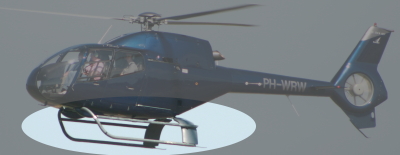Fuselage & Skid
The primary function of the fuselage (also called the airframe or hull) is to hold all of a helicopter’s components in place. It also: transfers the forces of the rotors, undercarriage,
and payload; protects the occupants from the elements; and contributes
to the aerodynamic behaviour of the helicopter, although
this is often compromised by
other requirements.
The construction of the fuselage resembles that of airplanes, and the same techniques
are used. It is often built around a frame of welded tubes, with the skin
structure attached to it. The undercarriage, transmission and engine regularly share
the same framework so that the other parts of the fuselage are not unduly stressed
on landing. Commonly used materials are steel (framework), aluminium for the seats and cabin
floor, plastics for the windows,
and fibre glass for the cabin’s skin. However, both the construction and materials
utilised are subject to a great deal of change as a result of ongoing research.
Indeed, composite materials are frequently used in the design of helicopters these
days as they are
less dense than metals and are inherently well damped. Moreover,
they do not suffer from
fatigue.

The skid gives the helicopter the ability to land on a surface, and
bears the helicopter’s weight on the ground. Skids are mainly used on light helicopters;
heavier models use wheels because skids are impractical when it comes to manoeuvring
the helicopter during ground operations. An important aspect of the skid is its
ability to absorb kinethic energy; firstly, to provide for a smooth touch-down when
landing, and secondly to absorb energy in the case of ground resonance. For these
reasons, oleo-pneumatic struts (oleos for short) are often used in skid design.
Next topic > Main Rotors & Rotorhead
|
Cyclic & Collective
- The title of this book leads me to wonder what more it will teach me in addition to its content about these two, most frequently used, helicopter input controls. As it turns out, the answer is: a lot more. Of course, all of the obligatory subjects like basic physics, rotor aerodynamics and helicopter performance are dealt with as well, as are piston engine and basic helicopter manoeuvres. Yet the scope of this book is actually much wider than one might initially think.
Firstly, it is divided into a 'beginners’ and an 'advanced’ section. This means that the book can treat more complex concepts in depth, even though the focus in the first section is directed more towards newcomers to the field.
Secondly, subjects like turbine engines, multi-engine helicopters and autopilots are also examined. This is particularly helpful, since these topics are not usually covered in the majority of helicopter books aimed at this target audience.
Thirdly, the book deals with many things that you will not normally find in a text book: helicopter related experiences and a great deal of interesting detail. This is the sort of information that can only be provided if you have flown a lot of different helicopters and have been working in this industry for some time. What’s more, this tone is amplified by the consistently narrative style of the book.
- 536 pages
|
|
Art of the Helicopter (Hardback)
- Well structured text that covers many technical aspects. It starts with an introduction to helicopters, followed by a treatment of
the technical background needed when studying them. Thereafter, dynamics, rotor systems, engines and transmission are explained in detail.
The book concludes with a section on performance and other types of rotorcraft. Its main asset is that the text is technically and
theoretically very accurate, and rather than mathematics, its focus is always on enabling the reader to achieve an understanding of
helicopters from a technical or engineering point of view. The more technically orientated reader will love this work.
- 416 pages
|
|
Principles of Helicopter Flight (Paperback)
- If you are wondering how a helicopter flies, and really want to comprehend the process, you have no choice but to delve into
aerodynamics. This means not only understanding which forces play a role and the laws of physics, but also being able to put it all
together and apply your knowledge to a rotating system consisting of a number of rotor blades. This is a demanding task and requires
some very hard work. It is, undoubtedly, worth the effort though, and will help you to become a better pilot. There are many books out
there to help you with this task of exploring the principles of helicopter flight, but they tend to fall into two camps:
populist and taking a rather simplistic approach, or highly technical and assuming the reader has a degree in mathematics.
This book is different, because it clearly explains the principles of flight in a step by step way that is easy for most
readers to follow. Further benefits are that a lot of attention is paid to flight manoeuvres and operations, and every chapter
concludes with questions as a study aid.
- 320 pages
|
Comments are disabled.